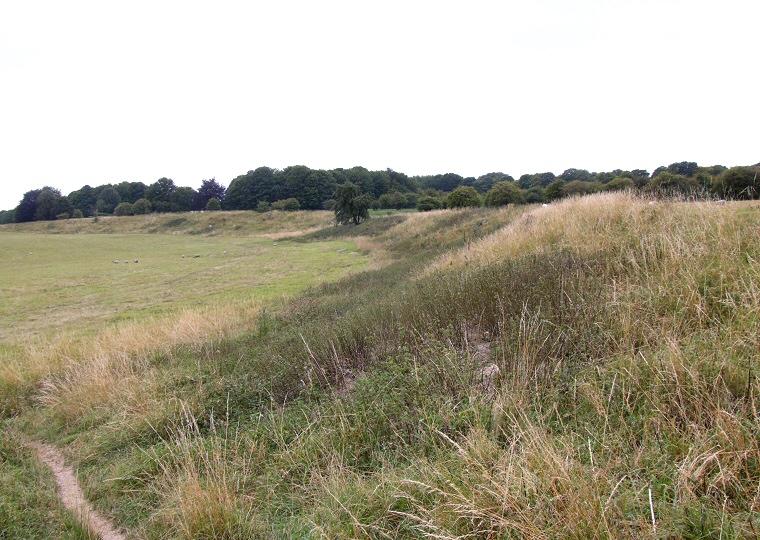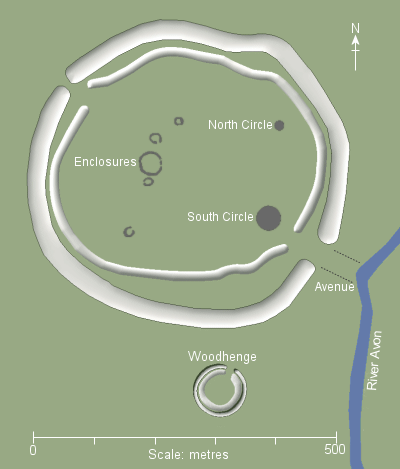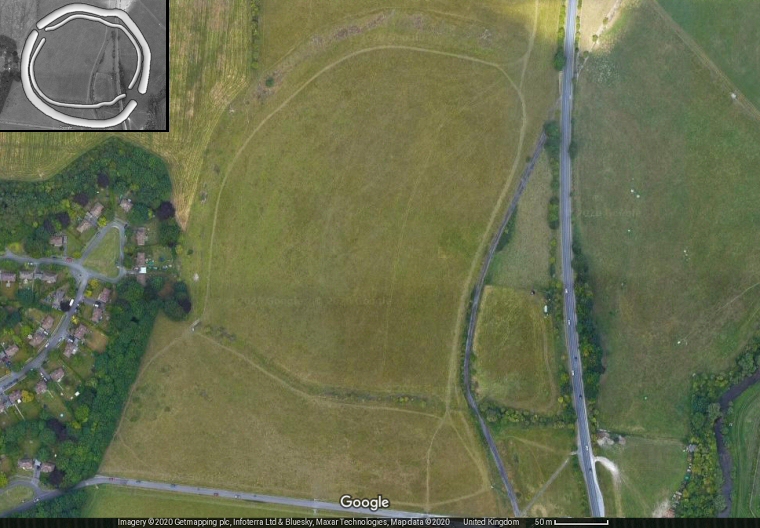 Durrington Walls - a view along the north-western bank from the north of the henge. |
|
Although there
is little to be seen on this site today Durrington Walls stands just
60 metres north of the more well known but much smaller Woodhenge
and 3km northeast of Stonehenge itself.
Built during the late Neolithic sometime around 2500BC the bank and ditch now covered with grass and bushes form the largest henge monument in Britain measuring some 520 metres north to south by 450 metres east to west. It was originally cut out of the chalk bedrock and consisted of an outer bank that measured nearly 30 metres wide and 3 metres in height with an internal leveled berm that varied between 6-40 metres wide with entrance gaps through the bank to the northwest and southeast - this south-eastern entrance stood about 100 metres away from the River Avon. Within the bank was the internal ditch structure from which the chalk used to construct the bank was quarried. It measured nearly 6 metres deep and 7 metres wide with causeways over the ditch again towards the northwest and southeast. Old OS maps show the location of a standing stone just a few metres outside the western bank and it  could be that this formed
some kind of portal beside the entrance but sadly this stone seems to
have disappeared in the early years of the 20th century. could be that this formed
some kind of portal beside the entrance but sadly this stone seems to
have disappeared in the early years of the 20th century.When the site was excavated by Geoff Wainwright between 1966-67 it was estimated that it would have taken nearly a million work-hours to shift over 100000 tones of chalk creating a stunning gleaming white monument against the rolling green grasslands of the Stonehenge landscape. The remains of this henge have been badly damaged by ploughing and it is even cut in two by the A345 road from Netheravon to Durrington yet the excavations in the 1960's revealed much valuable information, including the existence of a pair of wooden structures. The first, near the south-eastern entrance consisted of a series of five concentric rings of post holes, the outer ring having a diameter of 38 metres and the innermost being 27 metres. This could either have been an arrangement of freestanding timber posts perhaps linked with lintels similar to Woodhenge or the supports of a building that was rebuilt in several stages. There was a second smaller wooden structure around 120 metres to the north about 27 metres in diameter where an original pair of post rings were later replaced by two smaller rings. A geophysics survey of part of the 12 hectare site of Durrington Walls in 1996 revealed evidence of several other structures including a double ditched enclosure about 35 metres wide and four other smaller oval or rectangular enclosures as well as part of a later Iron Age field system. Excavations since 2006 by Mike Parker Pearson have also located a pair of low banks either side of a roadway linking the south-eastern entrance with the banks of the Avon as well as several associated rectangular structures that are interpreted as houses. This has lead to the theory that Durrington was linked physically and spiritually with Stonehenge, perhaps being the place where the newly deceased were brought and relatives held wakes and feasted before the body was taken down to the Avon. After a 7km river journey the body would then be taken ashore on its final journey overland to join the world of the ancestors in ceremonies conducted within the sanctity of the circle of Stonehenge. |
 Satellite image of Durrington Walls with an inset of the bank and ditch plan overlaid. Much of the earthwork of the site has now gone but the impressive bank shown in the photograph at the top of the page can still be seen to the top and left in this aerial view as well as its proximity to the River Avon, bottom right. |